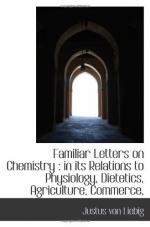For all great discoveries chemists are indebted to the “balance”—that incomparable instrument which gives permanence to every observation, dispels all ambiguity, establishes truth, detects error, and guides us in the true path of inductive science.
The balance, once adopted as a means of investigating nature, put an end to the school of Aristotle in physics. The explanation of natural phenomena by mere fanciful speculations, gave place to a true natural philosophy. Fire, air, earth, and water, could no longer be regarded as elements. Three of them could henceforth be considered only as significative of the forms in which all matter exists. Everything with which we are conversant upon the surface of the earth is solid, liquid, or aeriform; but the notion of the elementary nature of air, earth, and water, so universally held, was now discovered to belong to the errors of the past.
Fire was found to be but the visible and otherwise perceptible indication of changes proceeding within the, so called, elements.
Lavoisier investigated the composition of the atmosphere and of water, and studied the many wonderful offices performed by an element common to both in the scheme of nature, namely, oxygen: and he discovered many of the properties of this elementary gas.
After his time, the principal problem of chemical philosophers was to determine the composition of the solid matters composing the earth. To the eighteen metals previously known were soon added twenty-four discovered to be constituents of minerals. The great mass of the earth was shown to be composed of metals in combination with oxygen, to which they are united in one, two, or more definite and unalterable proportions, forming compounds which are termed metallic oxides, and these, again, combined with oxides of other bodies, essentially different to metals, namely, carbon and silicium. If to these we add certain compounds of sulphur with metals, in which the sulphur takes the place of oxygen, and forms sulphurets, and one other body,—common salt,—(which is a compound of sodium and chlorine), we have every substance which exists in a solid form upon our globe in any very considerable mass. Other compounds, innumerably various, are found only in small scattered quantities.
The chemist, however, did not remain satisfied with the separation of minerals into their component elements, i.e. their analysis; but he sought by synthesis, i.e. by combining the separate elements and forming substances similar to those constructed by nature, to prove the accuracy of his processes and the correctness of his conclusions. Thus he formed, for instance, pumice-stone, feldspar, mica, iron pyrites, &c. artificially.
But of all the achievements of inorganic chemistry, the artificial formation of lapis lazuli was the most brilliant and the most conclusive. This mineral, as presented to us by nature, is calculated powerfully to arrest our attention by its beautiful azure-blue colour, its remaining unchanged by exposure to air or to fire, and furnishing us with a most valuable pigment, Ultramarine, more precious than gold!




